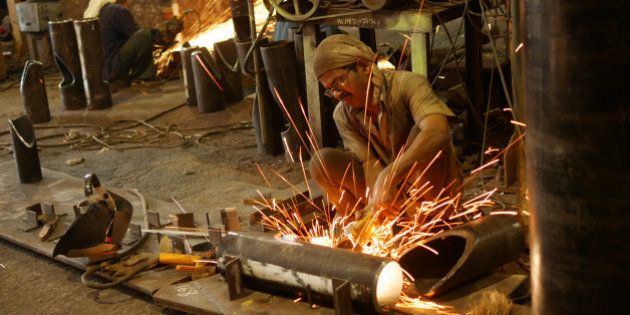
The much heralded Make in India Week is due in February, wherein the leviathan propaganda machine of the BJP/NDA sarkar will be unleashed in all its razzmatazz and glory, befitting the rock-star imagery of Prime Minister Narendra Modi. The celebrated Lion logo, paradoxically inspired by a Swiss bank emblem will walk majestically, never mind that manufacturing activity nosedived to a record 28-month low, exports tumbled down like Jack and Jill for 12 successive months and private investment remained as flat as a table-tennis table. And this appalling gloom pervades when global oil prices have crashed to approximately US$35 a barrel! So is Make in India a myth or a reality? The reality is that it is a myth.
Exactly 20 years ago, petite singer Alisha Chinai's song "Made in India" mesmerised us, and became an Indipop chartbuster. By repackaging the UPA's rather sombre-sounding New Manufacturing Policy with glittering branding , Modi has appeared to position himself as the pop-patriot of the manufacturing sector, which contributes 17% to India's GDP on a Napoleonic scale. Periodic blandishments from NRIs who throng his organised concerts abroad seem to reinforce to Modi that he is on a galloping stallion. But slogans, shibboleths have a temporary dazzling effect; they end up reflecting wasted monies and dashed expectations.
[E]ven Modi's own Statue of Unity of Sardar Patel has been outsourced to a Chinese foundry. This is grotesque double-speak.
Reportedly, 2.3 million people applied for 368 positions as government peons in Uttar Pradesh, many of them postgraduates and PhDs. It is thus apparent that job creation was expected to be a key objective of Modi Sarkar. But where are the 25 million jobs per annum in the promised land? Incidentally, even Modi's own Statue of Unity of Sardar Patel has been outsourced to a Chinese foundry. This is grotesque double-speak.
Have we already forgotten the macabre, tragic episode wherein Gajendra Singh Rathore, a devastated farmer from Rajasthan, committed suicide on live television? Of course we need manufacturing, but what are our concomitant priorities, such as protecting and boosting the livelihoods of small-marginal farmers and landless labour? What about delayed MNREGA pay-outs, drastic cutbacks in health/education expenditure, displacement of tribal populations and destruction of natural assets, while we continue juggernaut-like with our mindless obsession for physical capital. Eighteen of 29 states face drought conditions, while well over 2000 farmer suicides have occurred in Maharashtra alone in 2015. Indian agriculture that supports 70% of India's population, directly or indirectly, grew at a woebegone 0.2%; bad monsoons and unseasonal rains have become forceful headwinds.
The global trend to boost domestic jobs (a political hot button) has made both Make in USA and Make in China a reality, based on the comparative advantage theory. Even the formerly Dark Continent has a Factory Africa mission. Also, employment-creation is a mammoth challenge, as merely setting up massive production facilities does not guarantee jobs. Assembly lines are becoming capital-intensive and technology-efficient, making labour-absorption difficult. Also, Southeast Asian nations such as the Philippines, Malaysia, Indonesia, etc are becoming cost-effective on real wages. Robots are fast-replacing the blue collar workforce in Japan. Our favorite sales pitch on the "demographic dividend" advantage could easily become an onerous liability with an ill-equipped work force, hampered by poor health and inadequate knowledge and skills exposure. Let us remember that 1.5 million of our young die before attaining the age of five years.
Our favorite sales pitch on the "demographic dividend" advantage could easily become [a] liability with an ill-equipped work force, hampered by poor health and inadequate knowledge and skills exposure.
Digital broadband and Facebook free basics dominate discourse, but in the short-term, for the impoverished farmer, that is a puerile debate. Modi Sarkar's rather naïve belief in the trickle- down growth theory propounded by Columbia University professors in its think-tank has clearly boomeranged. Mere astronomical growth does not alone lift poverty levels; they need to be accompanied by a structured strategy for income redistribution, especially in an emerging market with accentuated economic inequities. Thus, even the US is anxious about flagrant income inequalities. In India, 1% of people have 53% of its wealth, and we boast of the third highest number of Forbes billionaires. As Joseph Stiglitz and Thomas Piketty have correctly pointed out, inequality hinders growth. The red flags are out. Even 35% of urban India is below BPL, so much as we blow the trumpet on proposed Smart Cities and the inevitable urban migration, the fact is that we are struggling with the provision of basic public amenities that need government expenditure.
In India, 2015 was unofficially christened as the Year of the Cow. A fractured society living on the precipitous edge of communal tensions cannot give you mind-boggling growth figures; in fact, it will derail the planned expansion. Artificial intelligence is clearly no match for natural stupidity; Love Jihad, Ghar Wapsi, Award Wapsi did incalculable damage to Brand India. We ignore the rising intolerance of right-wing fundamentalists who are fast metastasising into monstrous proportions at our own peril. In fact, it will not be an exaggeration to say that the cottage industry of bigoted fanatics has seen the most burgeoning growth rate under Modi Sarkar.
Short-sightedness can be self-destructive when you are supposed to be in the driver's seat. The passengers get hurt too.
Under UPA, the inclusive growth model saw a near-optimal manifestation -- 140 million people moved out of poverty on accounts of its "rights-based " approach that sought empowerment, even as higher FDI/private investment and public spending led to the second-fastest growing economy in the world (after China) at nearly 8% average GDP growth rates. And this stupendous accomplishment happened during the worst global crisis since the Great Depression.
Modi Sarkar needs to do a drastic course correction. The holistic Human Development Index seemed a low-priority, as "ease of doing business" overtook the government's agenda. Both are important, but the latter seemed to be more headline grabbing. Thirteen of the 20 most polluted cities in the world are in India; forest rights, green accounting and water security are barely being addressed by an essentially growth-driven government that sees reforms as merely opening up gateways to foreign funds. It is myopic. But short-sightedness can be self-destructive when you are supposed to be in the driver's seat. The passengers get hurt too.



Contact HuffPost India
Also see on HuffPost:
